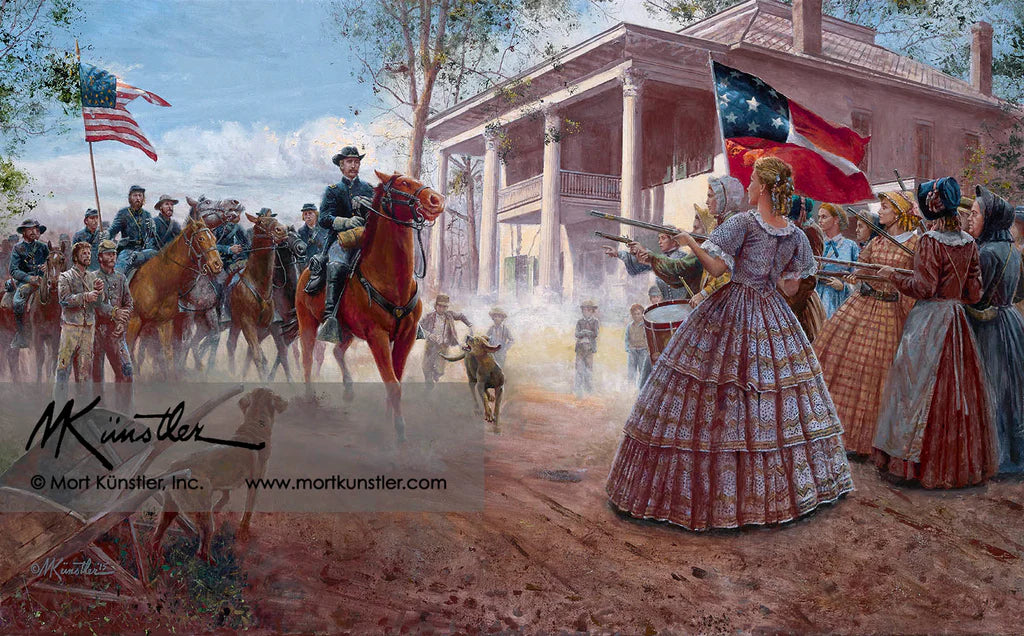Künstler
LaGrange vs. LaGrange
LaGrange vs. LaGrange
Couldn't load pickup availability
This is Mort Künstler limited edition print - LaGrange vs. LaGrange. LaGrange, Ga., April 17, 1865.
Giclée Canvas Prints
Reproduction technique: Giclées are printed with the finest archival pigmented inks on canvas.
Each print is numbered and signed by the artist and accompanied by a Certificate of Authenticity.
Signature Edition Size: 16” x 26”
Signed & Numbered • Edition Size: 100
Artist’s Proof • Edition Size: 10
Classic Edition Size: 20” x 32”
Signed & Numbered • Edition Size: 50
Artist’s Proof • Edition Size: 10
Premier Edition Size: 23” x 37”
Signed & Numbered • Edition Size: 15
Artist’s Proof • Edition Size: 5
Collector’s Edition Size: 35” x 56”
Signed & Numbered • Edition Size: 5
Artist’s Proof • Edition Size: 2
Historical Information
As with most military conflicts, the call to duty naturally depletes the male population who marches off to war. This often leaves the care of the farms and homesteads in the hands of their able-bodied wives. Sometimes the war comes to town, requiring women to take up arms in defense of their homes and firesides.
In April of 1861 the LaGrange Light Guards of the Fourth Georgia deployed to fight for the Confederacy. This unit was made up of thirteen hundred troops, the majority of LaGrange’s men. Their sudden absence left the town vulnerable to a Union attack. As a result the women of LaGrange eventually formed an all-female militia known as the “Nancy Harts.”
Inexperienced with the use of tactics and firearms, the women turned to A. C. Ware, a local physician who remained in town due to a physical disability, for assistance in their training. He turned to William J. Hardee’s manual, titled Rifle and Light Infantry Tactics. The ladies of LaGrange met twice a week for drilling and target practice. Prizes were awarded for the best shots.
On April 17, 1865 the Nancy Harts marched to the campus of LaGrange Female College to meet the Union cavalry that was advancing on the town. Outgunned and outnumbered, the women peacefully surrendered the town to Union Colonel Oscar H. LaGrange. In return, Union troops spared the town’s homes and properties and focused their destruction on the railroad as it was helpful to the Confederate war effort.
After the war, members of the Nancy Harts returned to their prewar duties, though many were forced to make life-changes because more than a quarter of LaGrange’s enlisted men did not return home. Many of these women joined the LaGrange chapter of the United Daughters of the Confederacy (UDC) and worked diligently to preserve the memory of their sons and husbands.
Mort Künstler’s Comments
I received a letter from R. Chris Cleaveland dated May 14, 1993. Enclosed was his published article recounting one of the most fascinating stories to come out of the Civil War. The following is a verbatim quote from the historical marker outside the Troup County Courthouse that tells that story:
The Nancy Harts
In 1863, a company of women soldiers was formed in LaGrange by Mrs. J. Brown Morgan. They called themselves the “Nancy Harts” in honor of Georgia’s Revolutionary War heroine. Organized to defend LaGrange in the absence of its men, the Nancy Harts held drills and target practice and became proficient at each. On April 17, 1865, a column of Union cavalry was reported to be approaching LaGrange from the west. This column, the 2nd Brig. 1st. Div., of Wilson’s cavalry corps, was commanded by Col. O. H. LaGrange, 1st Wis. Cav. On the 16th, it had crossed the Chattahoochee River at West Point (18 miles SW), captured Fort Tyler, a strong redoubt commanding the town, and destroyed the bridges, the rail facilities, 19 locomotives, 340 cars loaded with army supplies, and much valuable machinery. Early on the 17th, it had marched toward LaGrange, destroying the railroad enroute. The Nancy Harts mobilized promptly, determined to resist any attempted depredations, but they were spared a trial at arms. Seeing the charmingly militant array formed to meet him, Colonel LaGrange complimented them upon their fearless spirit and fine martial air and, after a brief delay, marched on toward Macon, leaving no scar other than the broken railroad to deface this gracious Georgia town whose name he chanced to bear.
All this happened a week after Robert E. Lee had surrendered at Appomattox, and what made it even more remarkable was that the Colonel bore the same name as the town.
On March 6, 2005, I was in Cartersville, Georgia for the opening of my exhibit, American Spirit Remembered: The Art of Mort Künstler, at the Booth Western Art Museum. The museum’s executive director, Seth Hopkins, and I were on our way to a talk I was to give at the National Civil War Naval Museum at Port Columbus in Port Columbus, Georgia, when I saw an exit sign for LaGrange. I asked Seth if he knew the story; he said he did, and that he had lived and worked in LaGrange from 1989 to 1991. On the way back from my talk the next day, we stopped at the exact spot where the incident took place, and then we went to the Troup County Archives, where Kaye Lanning Minchew, the executive director, shared the archives’ historical documentation and pictures with us. I was overwhelmed by the beauty of the Yancey-Smith House, still there since 1842, and thought it would make a perfect backdrop for my painting.
I left it on the back burner and eventually got involved in many other projects. I announced that I was doing my final eight paintings of the Civil War. In any case, I could not get the story of the Nancy Harts out of my mind, and I decided to do one more painting. I believe this one really does it!
Share


Continue Shopping
See more of the Breagans' collection of manufacturers from all around the world
Subscribe to our emails
Subscribe to our mailing list for insider news, product launches, and more.

